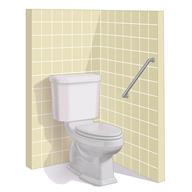How to Prevent Falls in the Home for Adults
Falls can cause injuries. Falls can happen to people of all ages. There're many things you can do to make your home safe and to help prevent falls.
If you need it, ask for help making these changes.
What can I do to prevent falls?
Things you can do in the bathroom
-
Keep the floor dry. Clean up any water that's on the floor right away.
-
Remove soap buildup. Clean the bathtub or shower to prevent slippery spots.
-
Use non-skid mats or decals on the floor of the bathtub or shower.
-
Secure bath mats. Use double-sided, non-slip rug tape to keep bath mats in place.
-
Use a non-slip stool if you need to sit while showering.
-
Install grab bars by the toilet and in the bathtub and shower. Do not use towel bars as grab bars.
Things you can do in the bedroom
-
Have a light by your bed. Make sure it is easy to reach.
-
Do not use any sheets or blankets on your bed that hang to the floor.
-
Use a firm chair. Have a sturdy chair with arms that you can use for support when you get dressed.
-
Keep a phone by your bed. This way, you can call for help if needed.
Things you can do in the kitchen
-
Clean up any spills right away.
-
If you need to reach something above you, use a step stool that has a grab bar.
-
Keep electrical cords out of the way.
-
Do not use floor polish or wax that makes floors slippery.
Things you can do with your stairs
-
Keep stairs clear. Do not leave anything on the stairs.
-
Make sure that you have a light switch at the top and the bottom of the stairs. Have them installed if you don't have them.
-
Check handrails. Ensure there're handrails on both sides of the stairs. Fix any broken or loose handrails.
-
Install non-slip stair treads on all stairs in your home if they don't have carpet.
-
Do not place throw rugs at the top or bottom of stairs. You can also secure the rugs with carpet tape to prevent them from moving.
-
Choose safe carpet. Use carpet that doesn't hide the edge of the steps and is firmly attached.
Things you can do on the outside of your home
-
Use bright outdoor lighting.
-
Repair walkways and driveways. Fix cracks and remove anything that can trip you, like tools or rocks.
-
Mark steps. Use color or contrast paint to mark raised steps or doorways.
-
Trim any bushes or trees on paths to your home.
-
Check handrails. Make sure handrails are not loose or broken.
-
Install guardrails along the edges of any raised decks or porches.
-
Remove leaves, snow, and ice regularly. Use sand, salt, or ice melt on walkways during winter months.
-
Clean up garage spills. Clean up any grease or oil spills right away.
Other things you can do
-
Review your medicines. Talk to your health care provider about your medicines. Some can make you dizzy or confused.
-
Wear supportive shoes. Choose closed-toe shoes that fit well and have rubber soles.
-
Use a cane, walker, scooter, or crutches to help you move around, if needed.
-
Talk to your provider. Ask about exercises that can improve your strength and balance. A physical therapist can help you with this.
General tips
- Use good lighting. Make sure all rooms are well-lit.
-
Keep items that you use often in easy-to-reach places. Lower the shelves around your home if needed.
-
Move furniture to create clear paths.
-
Do not keep throw rugs or other things on the floor. They can make you trip.
-
Fix uneven floors.
- Add color or contrast paint or tape to clearly mark and help you see:
- Use ladders safely.
-
Know where your pets are as you move through your home.
-
Centers for Disease Control and Prevention, STEADI:
cdc.gov
-
-
Contact a health care provider if:
-
You're afraid of falling.
-
You feel weak, drowsy, or dizzy.
-
You fall.
These symptoms may be an emergency. Call 911 right away.
This information is not intended to replace advice given to you by your health care provider. Make sure you discuss any questions you have with your health care provider.

